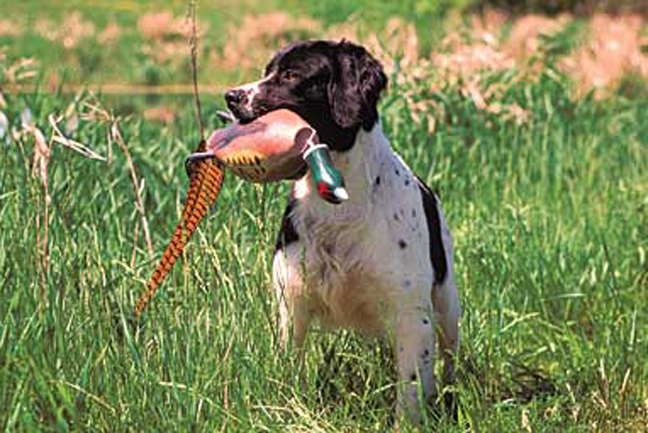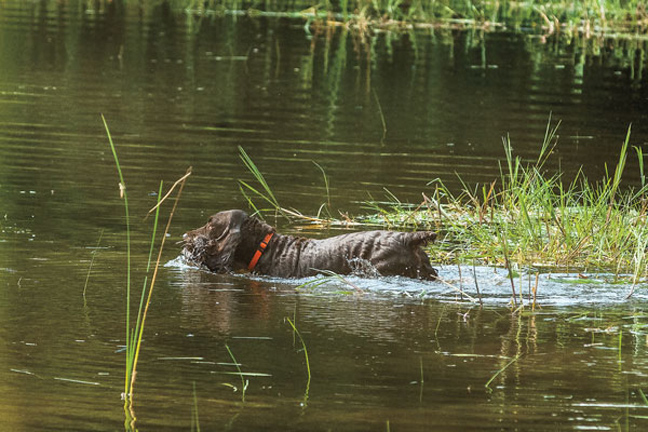With the arrival of warm weather, gun dog owners must be overly mindful of the stress that training in warm weather places on a dog. Overheating during warm weather training sessions can lead to death if you're not mindful of the signs to look for that your dog is beginning to suffer from heat exhaustion. Here are the 10 best training tips to keep your dog from falling victim to overheating for pointing, retrieving and flushing breeds.
POINTING BREEDS
"When the temperature gets above about 65 degrees," Roger Buddin of Big Country Kennel said, "you should start watching for signs of overheating in your dog, even if you're quite comfortable. In training, your dog works harder than you do. He runs while you walk, and he covers a lot more ground than you do. Then, too, being a bird dog, he just doesn't know when to quit. So it's up to you to keep him from overheating. Be especially careful if he's out of shape."
Roger stressed that an overheated dog can die very quickly if not cooled down. Thus you should watch for the early symptoms and take immediate action if they appear. Initially, your dog will start panting more and more profusely. If not cooled down, he will next start wobbling around in circles. Then he'll have a seizure and collapse, after which he will die within minutes.
1. Cool them Down Quick
If your dog starts panting noticeably, you should get him into a shady area right away and give him water to drink. You shouldn't put him in a crate until he has stopped panting. If your dog should ever suffer the later stages (staggering and so forth), you should get him into water, a pond or stock tank, immediately. Lacking a pond or stock tank, you should pour water over his head and chest.

"I've found that rubbing a little alcohol in his ears," Roger said, "also helps cool him down."
2. Keep Travel Kennel Well Ventilated
When traveling to and from the training grounds in warm weather, you should keep your dog in a well-ventilated crate in a well-ventilated place in your vehicle, preferably with drinking water available for him. You shouldn't put more than one dog in a crate. Ideally, you should travel only in the early morning and late evening.
While on the training grounds but not running your dog, you should keep him staked out in a shady area with drinking water available. When he's staked out and you are helping someone else run his dog, you should check on your dog frequently.
3. Hit the Bottle Often
Before running your dog, you should wet down his head and chest. You should always carry a squirt bottle full of water so you can give him occasional drinks while he's running.
"In warm weather," Roger said, "don't run your dog very long. Watch him closely for signs of tiring. Try to pick him up just before he starts to tire. For that, you have to know your dog."
Roger pointed out that, in warm weather, scenting conditions are usually rather poor. Wind and humidity help, but finding birds on hot, dry, windless days can be impossible, so don't expect too much of your dog. Mornings and evenings are the best times to train under such conditions.
As a final thought, Roger added this: "If the weather's too warm for you, it's way too warm for your dog, so don't take any chances on harming him. He loves to run and hunt, and he depends on you to keep him from overheating. It's also your responsibility to keep him in proper condition for the work you expect of him."
RETRIEVERS
"Dogs begin to suffer the effects of heat," Greg Lister of Innisfree Kennels said, "when the temperature reaches 70 degrees, and they suffer from it far more than we humans do."
Why are they so much more susceptible to overheating than humans? Because, in a typical training session, the dog works so much harder than his owner does. Greg explained this with an example from everyday retriever training: Consider a triple land marking test, in which the birds fall at 350 yards, 225 yards, and 110 yards. To complete that test, even if he pins all three marks, which is unlikely, the dog must run 1,370 yards! He must run even farther if he has to hunt for any of them. All that time, the handler is standing still at the line.
"In heavy cover," he added, "the heat is even more intense. Plus, when carrying a bird, the dog cannot pant, which is how a dog cools down."

4. Watch for These Trouble Signs
Greg said the early signs of overheating are heavy panting, followed by wobbling around. If left untreated, the dog will collapse and then soon die. Thus, when you see the early signs in your dog, you should realize that the situation is very serious and that you must take immediate action. You should cool your dog down right away.
Greg recommends applying cool water to areas where blood flows heavily, like the insides of the legs and around the ears. You should also get your dog to lie down in the shade.
"One good shady spot," he said, "is the front seat of your vehicle, with the air conditioning running full blast, blowing cool air on him."
If your dog is in the later stages of overheating, Greg said you must get him to a veterinarian as quickly as possible.
5. Avoid Heavy Cover Workouts
To prevent overheating in warm weather, he recommends that you avoid training areas with heavy cover, and that you include water work in your tests. In land tests, you should set things up so the dog has to run or swim through a stream or pond on his way to the marks and blinds.
""During warm weather, train early in the morning and in the evenings. If that isn't possible, try to teach just one task per day."
In traveling to and from the training grounds, you should keep your dog in a well-ventilated place in your vehicle. When you arrive, you should stake him out in a shady area, with drinking water available for him. While other dogs are running, you should check on your staked-out animal rather often.
6. Don't Do Long Marks
"When it's warm," Greg said, "I don't set up long marks and blinds. I also run a lot of singles off of multiple set-ups. If a dog has a long hunt on a mark, I stop working him immediately. I won't let him continue and risk becoming overheated. It just isn't worth it. It's better to stop, cool him down, and then get him back out later."
7. Check Your Birds
Greg said that during warm weather, you have to check the dead birds you use and re-use in training. They can deteriorate rapidly. Birds too far gone can lead to training problems. Some dogs blink them; others chew them. You're out there to solve problems, not to create them. Greg has his bird throwers carefully check every bird before throwing it.
"We shoot a lot of birds in training," he said, "so we always have plenty of dead ones to use for control birds. We keep them in the freezer every night."
Scenting conditions are often poor during the warmer months. Everything is growing and blooming and giving off strong scents. Green cover tends to mask the birds' scent. Then, too, dogs sometimes breathe through their mouths, at least off and on, which makes scenting almost impossible.
"Don't throw birds into heavy cover," Greg said. "Your dog might mark the bird well but still fail to find it because the cover blocks its scent. In a marking test, if your dog gets to the area, you want him to find the bird."
"Also, don't give many reruns in summer. Dogs can't learn when they're not focused. Keep your dog fresh."
SPANIELS
"Many factors contribute to the risk of overheating," Hal Cheney of Linden Kennels said, "like temperature, humidity, wind strength (or lack thereof), sunshine or clouds, cover density, and the physical condition of the dog. You have to know your dog, and you have to watch your dog, and then you have to use common sense to determine when he's in danger of overheating."
Hal stressed that dogs are more susceptible than humans to overheating, primarily because they don't sweat to stabilize their body temperature; they can only pant. Then, too, while training, zig-zagging spaniels move faster and cover more ground than their walking handlers. He said the signs of overheating are progressive: first, the dog pants excessively; then he appears distressed; then he staggers drunkenly; and finally he collapses, after which he will die very quickly.
8. Stop At the First Sign of Overheating
"When your dog shows the first signs of overheating," he said, "stop training, get him out of the sun, give him a drink of water, and start wetting him down thoroughly. As you soak him, rub the water down into his skin with your hand. And then, above all, learn from that experience. Don't ever let it happen again!"

Hal said that the ideal warm weather training area for spaniels has brome-grass cover mowed to a height of about 16 inches, as you can find in a field that has been recently mowed for hay. You should avoid tall, thick cover that tangles in your dog's coat.
9. Use a Frozen Milk Jug
To keep your dog cool while traveling to and from the training grounds, Hal recommends plenty of ventilation plus perhaps frozen milk jugs full of water in the dog's crate. He will lick them and rub against them. While on the training grounds, but not actually working, you should keep your dog in a shady area, with drinking water and good ventilation, and if possible with a fan blowing on him
While actually running, your dog relies on your judgment as to when he's had enough. You need to know his physical condition, and you must watch him for any sign of overheating. You should always err on the side of caution. Give him short runs and frequent drinks. For the latter, you need to carry water with you while working your dog.
Hal said that scenting conditions can be poor during warm weather, especially in heavy cover with little or no wind. Thus you should do your training in lighter cover and only when there is a reasonable breeze blowing.
10. Use Birds That Stay Put
"Then, too," he added, "Your pooch can't smell much of anything when he's panting with his tongue hanging out! With a young spaniel, don't use birds that run in the summer. Such birds will confuse the pup and booger up his flush. He'll begin to take a long time to put birds in the air.
"Instead, use birds that stay put, like slightly dizzied pigeons. These build your spaniel's confidence and thus encourage the hard flush you want him to have."
As a final thought, Hal added this: "People must realize that, in summer, they have to work around the weather. Sometimes it will be too hot and still to accomplish anything in the field.
"In such a case, you should stay at home and do yard-training or "hold" and "give" work on the bench. Do something that won't take more out of your dog than your training lesson will put into him."






